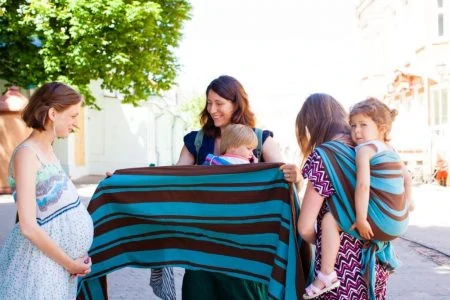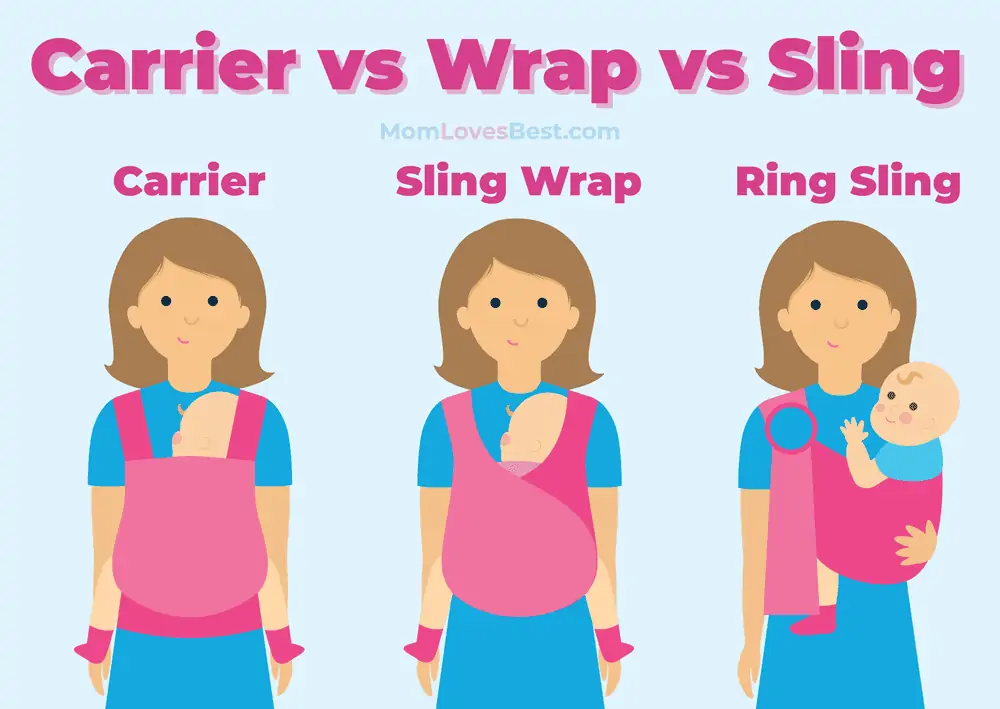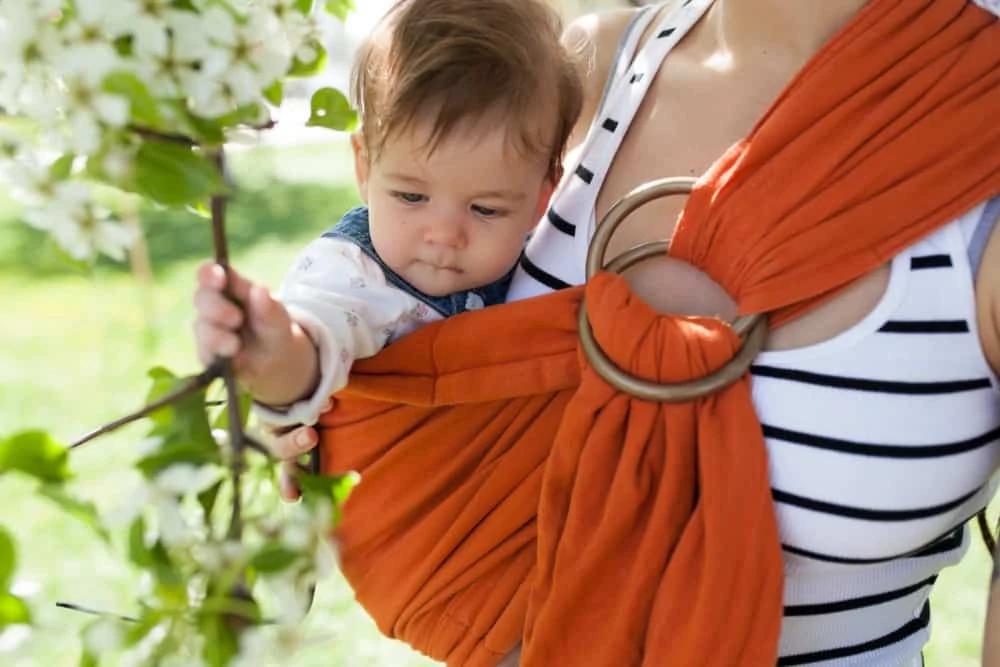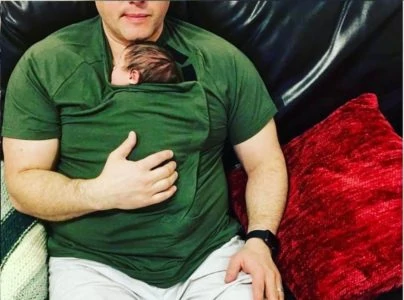Babywearing is a game-changer for parents, but staring at the wall of options at the store is intimidating. Wraps, slings, soft-structured carriers; what is the actual difference?
You aren’t alone in the confusion. Most moms struggle to figure out which style fits their lifestyle best. Each type serves a different purpose, and finding the “best” one depends entirely on your specific needs.
We have raised dozens of babies between us, so our team has tested practically every fabric and buckle on the market. We want to help you cut through the noise so you can enjoy those baby snuggles hands-free.
We will break down the three most common babywearing options to help you decide which one belongs on your registry.
Key Takeaways
- Soft-structured carriers are user-friendly and quick to put on, but they can be bulky and often require an infant insert for newborns.
- Baby wraps offer a custom fit and supreme comfort, but they come with a steeper learning curve to master the tying techniques.
- Ring slings are fantastic for quick ups and downs with toddlers, though they put all the weight on one shoulder.
- Your choice should depend on your budget, your baby’s current age, and how long you plan to wear them during the day.
Soft-Structured Carriers
A soft-structured baby carrier (SSC) is the “backpack” of the babywearing world. It is the most common type you see out and about. It features padded shoulder straps, a thick waistband, and buckles that secure the baby against your chest or back.
SSCs come in a massive variety of brands like Ergobaby, Tula, and Lillebaby. You can also accessorize them with drool pads, rain covers, and hoods.
Why Use a Soft-Structured Carrier?
These carriers are the most user-friendly option for beginners. There is no complex tying involved; you just clip the buckles and tighten the straps.
SSCs are also highly versatile:
- Ease of use: They are quick to put on and take off, making them great for running errands or quick walks.
- Multiple positions: Most allow for front-inward, hip, and back carrying. Some even allow forward-facing.
- Longevity: Many styles adjust to fit babies from infancy well into toddlerhood (up to 45 lbs or more).
- Shared use: The adjustable straps make it easy to swap the carrier between parents of different sizes.
Why They May Not Work for You
While convenient, soft-structured carriers have a few downsides. High-quality models are expensive, often ranging from $100 to $200. They are also bulky, so they take up a lot of space in a diaper bag.
Newborn fit is another common issue. Many SSCs require a separate, bulky infant insert to safely hold a small baby. Without it, the baby may slump or not be high enough for you to monitor their breathing. Some parents also find the waistbands hot and sweaty during the summer months.
What You Should Know Before Buying
Before investing in an SSC, check these factors to ensure the best fit:
- Check the seat width: Look for an adjustable base that can widen as your baby grows to ensure knee-to-knee support.
- Verify newborn requirements: Check if the specific model requires an extra insert for babies under 12-15 lbs.
- Test the fit: If possible, try one on in a store. Some fit petite parents better, while others are great for taller frames.
Hip Health Matters
Baby Wraps
A baby wrap is essentially a long piece of fabric that you tie around your body to create a pocket for your baby. You can choose a stretchy wrap (like a Moby or Solly Baby) or a woven wrap.
Why Should I Consider a Wrap?
Wraps provide the most custom fit of any carrier. Because you tighten the fabric strand by strand, it molds perfectly to your baby’s body and yours. This makes baby wraps incredibly comfortable for long periods.
Stretchy wraps are the ultimate “fourth trimester” tool. The fabric is soft like a t-shirt and gentle on a newborn’s skin. You can pre-tie a stretchy wrap before putting the baby in, which is less stressful for beginners.
Woven wraps are the heavy lifters. They have no stretch, meaning they are supportive enough for heavy toddlers and safe for back carrying. They come in stunning patterns and blends like linen, wool, and cotton to suit different climates.
Woven wraps also come in numbered sizes (Size 2 to Size 8). Your “base size” usually depends on your clothing size and allows you to do the most common carries.
The Cons of Using a Wrap
The biggest barrier to wrapping is the learning curve. It looks like origami to the uninitiated.
- Learning curve: It takes practice to get the tension right. If it is too loose, the baby sags; too tight, and you are both uncomfortable.
- Heat: Stretchy wraps usually require three layers of fabric over the baby, which can be very hot in the summer.
- Length: The long tails of fabric can drag on the ground while you are tying it, which is annoying in parking lots.
- Stretchy limits: Stretchy wraps generally start to sag and become uncomfortable once the baby hits 15-20 lbs.
What To Know Before Buying
If you have a newborn, a stretchy wrap is an affordable and cozy place to start. If you want one carrier to last from birth to preschool, a woven wrap is a great investment, but be prepared to watch YouTube tutorials to learn the skills.
Ring Slings
If wraps seem too complicated but buckles feel too bulky, a ring sling is the happy medium. It consists of a long piece of fabric with two rings sewn at one end.
What Are the Benefits of Slings?
Ring slings are fast. Once you have the fabric threaded, you just pop the baby in and tighten.
- Breathability: It is only one layer of fabric over the baby, making it the coolest option for hot weather.
- Breastfeeding: It is very easy to lower the baby slightly to nurse while in the sling.
- Toddler ups-and-downs: As babies get nosy, they want to be up one minute and down the next. Slings are perfect for this.
- Hip carry: This mimics the natural way you hold a baby on your hip, but hands-free.
What Are the Cons of Slings?
The main drawback is weight distribution. Because a ring sling goes over one shoulder, all the baby’s weight is on that side. This can cause back or neck strain if you wear it for long hikes or if you have a heavy toddler.
There is also a learning curve to getting the “seat” right. You must tuck the fabric deep under the baby’s bottom to ensure they don’t slide out.
Can You Make Your Own Sling?
Yes! If you are crafty (or just thrifty), you can make a ring sling without sewing a stitch.
To make your ring sling:
- Get your supplies: You need a woven wrap (short size) and a pair of seamless aluminum rings. Use rings specifically made for babywearing to ensure safety.
- Position the fabric: Fold one end of your wrap. Place it so the shorter tail goes down your back, but not fully around to your side.
- Thread the rings: Gather the fabric at the fold and pull it through both rings. Ensure the fabric is not twisted in the rings.
- Back over the shoulder: Spread the rings apart. Take the tail end, loop it back over the top ring, and tuck it under the bottom ring.
- Secure it: Pull the fabric through to secure it, just like a belt buckle. Spread the fabric across your shoulder for comfort.
How to use a ring sling:
How to create a no-sew ring sling:
FAQs
In Conclusion
The “best” baby carrier is simply the one you will actually use. If complex wrapping stresses you out, go for the buckles of a soft-structured carrier. If you want newborn snuggles on a budget, grab a stretchy wrap.
Don’t be afraid to try a few different styles or look for a local babywearing group where you can test them out. Once you find the right fit, you will wonder how you ever parented without it.
















